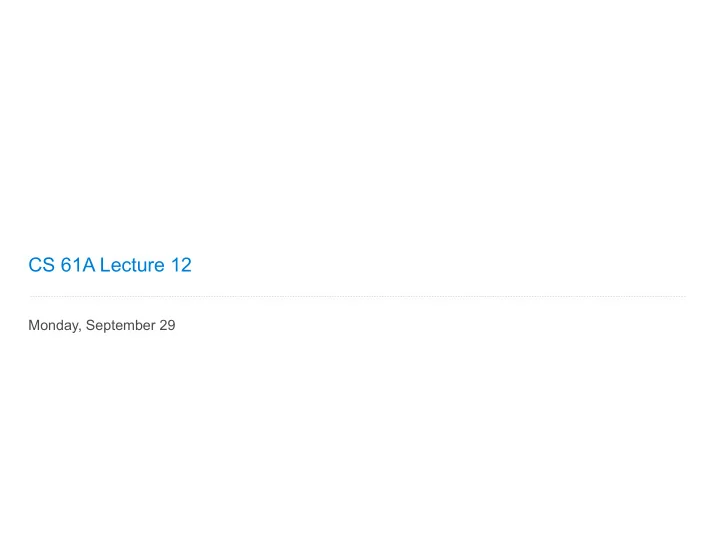

CS 61A Lecture 12 Monday, September 29
Announcements • Homework 3 due Wednesday 10/1 @ 11:59pm � Homework Party on Monday 9/29, time and place TBD • Optional Hog Contest due Wednesday 10/1 @ 11:59pm • Project 2 due Thursday 10/9 @ 11:59pm 2
Box-and-Pointer Notation
The Closure Property of Data Types • A method for combining data values satisfies the closure property if: • The result of combination can itself be combined using the same method. • Closure is the key to power in any means of combination because it permits us to create hierarchical structures. • Hierarchical structures are made up of parts, which themselves are made up of parts, and so on. Lists can contain lists as elements 4
Box-and-Pointer Notation in Environment Diagrams Lists are represented as a row of index-labeled adjacent boxes, one per element Each box either contains a primitive value or points to a compound value Interactive Diagram 5
Trees
Trees are Nested Sequences A tree is either a single value called a leaf or a sequence of trees Typically, some type restriction is placed on the leaves. E.g., a tree of numbers: 7
Tree Processing Uses Recursion (Demo) Processing a leaf is often the base case of a tree processing function The recursive case often makes a recursive call on each branch and then aggregates def count_leaves(tree): """Count the leaves of a tree.""" if is_leaf(tree): return 1 else: branch_counts = [count_leaves(b) for b in tree] return sum(branch_counts) 8
Discussion Question Complete the definition of flatten, which takes a tree and returns a list of its leaves Hint : If you sum a sequence of lists, you get 1 list containing the elements of those lists >>> sum([[1], [2, 3], [4]], []) def flatten(tree): [1, 2, 3, 4] """Return a list containing the leaves of tree. >>> sum([[1]], []) � [1] >>> tree = [[1, [2], 3, []], [[4], [5, 6]], 7] >>> sum([[[1]], [2]], []) >>> flatten(tree) [[1], 2] [1, 2, 3, 4, 5, 6, 7] """ if is_leaf(tree): return [tree] else: sum([flatten(b) for b in tree], []) return ___________________________________ � def is_leaf(tree): return type(tree) != list 9
Sequence Operations
Membership & Slicing Python sequences have operators for membership and slicing Membership . >>> digits = [1, 8, 2, 8] >>> 2 in digits True >>> 1828 not in digits True Slicing. >>> digits[0:2] Slicing creates a new object [1, 8] >>> digits[1:] [8, 2, 8] 11
Binary Trees Trees may also have restrictions on their structure A binary tree is either a leaf or a sequence containing at most two binary trees The process of transforming a tree into a binary tree is called binarization def right_binarize(tree): """Construct a right-branching binary tree. � >>> right_binarize([1, 2, 3, 4, 5, 6, 7]) [1, [2, [3, [4, [5, [6, 7]]]]]] """ if is_leaf(tree): All but the first branch are grouped into a new branch return tree if len(tree) > 2: tree = [tree[0], tree[1:]] return [right_binarize(b) for b in tree] (Demo) 12
Strings
Strings are an Abstraction Representing data: '200' '1.2e-5' 'False' '(1, 2)' Representing language: """And, as imagination bodies forth The forms of things to unknown, and the poet's pen Turns them to shapes, and gives to airy nothing A local habitation and a name. """ Representing programs: 'curry = lambda f: lambda x: lambda y: f(x, y)' (Demo) 14
String Literals Have Three Forms >>> 'I am string!' 'I am string!' � Single-quoted and double-quoted >>> "I've got an apostrophe" strings are equivalent "I've got an apostrophe" � >>> ' 您好 ' ' 您好 ' >>> """The Zen of Python claims, Readability counts. Read more: import this.""" 'The Zen of Python\nclaims, Readability counts.\nRead more: import this.' A backslash "escapes" the "Line feed" character following character represents a new line 15
Strings are Sequences Length and element selection are similar to all sequences >>> city = 'Berkeley' >>> len(city) 8 >>> city[3] Careful: An element of a string is itself a 'k' string, but with only one element! However, the "in" and "not in" operators match substrings >>> 'here' in "Where's Waldo?" True >>> 234 in [1, 2, 3, 4, 5] False >>> [2, 3, 4] in [1, 2, 3, 4, 5] False When working with strings, we usually care about whole words more than letters 16
Dictionaries {'Dem': 0}
Limitations on Dictionaries Dictionaries are unordered collections of key-value pairs Dictionary keys do have two restrictions: • A key of a dictionary cannot be a list or a dictionary (or any mutable type ) • Two keys cannot be equal; There can be at most one value for a given key This first restriction is tied to Python's underlying implementation of dictionaries The second restriction is part of the dictionary abstraction If you want to associate multiple values with a key, store them all in a sequence value 18
Recommend
More recommend